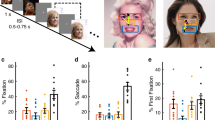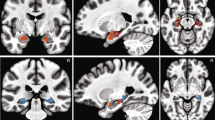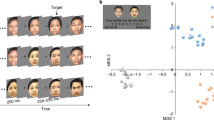Abstract
People instantaneously evaluate faces with significant agreement on evaluations of social traits. However, the neural basis for such rapid spontaneous face evaluation remains largely unknown. Here, we recorded from 490 neurons in the human amygdala and hippocampus and found that the neuronal activity was associated with the geometry of a social trait space. We further investigated the temporal evolution and modulation on the social trait representation, and we employed encoding and decoding models to reveal the critical social traits for the trait space. We also recorded from another 938 neurons and replicated our findings using different social traits. Together, our results suggest that there exists a neuronal population code for a comprehensive social trait space in the human amygdala and hippocampus that underlies spontaneous first impressions. Changes in such neuronal social trait space may have implications for the abnormal processing of social information observed in some neurological and psychiatric disorders.
This is a preview of subscription content, access via your institution
Access options
Subscribe to this journal
Receive 12 print issues and online access
$259.00 per year
only $21.58 per issue
Buy this article
- Purchase on Springer Link
- Instant access to full article PDF
Prices may be subject to local taxes which are calculated during checkout




Similar content being viewed by others
Data availability
All data are publicly available on OSF (https://osf.io/a4jn3/).
References
Willis J, Todorov A. First impressions: making up your mind after a 100-Ms exposure to a face. Psychological Sci. 2006;17:592–8.
Todorov A, Olivola CY, Dotsch R, Mende-Siedlecki P. Social attributions from faces: determinants, consequences, accuracy, and functional significance. Annu Rev Psychol. 2015;66:519–45.
Chang L, Tsao DY. The code for facial identity in the primate brain. Cell. 2017;169:1013–28.
Freiwald WA, Tsao DY, Livingstone MS. A face feature space in the macaque temporal lobe. Nat Neurosci. 2009;12:1187–96.
Leopold DA, Bondar IV, Giese MA. Norm-based face encoding by single neurons in the monkey inferotemporal cortex. Nature. 2006;442:572–5.
Montagrin A, Saiote C, Schiller D. The social hippocampus. Hippocampus. 2018;28:672–9.
Rutishauser U, Mamelak AN, Adolphs R. The primate amygdala in social perception—insights from electrophysiological recordings and stimulation. Trends Neurosci. 2015;38:295–306.
Adolphs R, Tranel D, Damasio AR. The human amygdala in social judgment. Nature. 1998;393:470–4.
Todorov A, Baron SG, Oosterhof NN. Evaluating face trustworthiness: a model based approach. Soc Cogn Affect Neurosci. 2008;3:119–27.
Wang S, Yu R, Tyszka JM, Zhen S, Kovach C, Sun S, et al. The human amygdala parametrically encodes the intensity of specific facial emotions and their categorical ambiguity. Nat Commun. 2017;8:14821.
Said CP, Sebe N, Todorov A. Structural resemblance to emotional expressions predicts evaluation of emotionally neutral faces. Emotion. 2009;9:260–4.
Oosterhof NN, Todorov A. The functional basis of face evaluation. Proc Natl Acad Sci USA. 2008;105:11087–92.
Sutherland CAM, Oldmeadow JA, Santos IM, Towler J, Michael Burt D, Young AW. Social inferences from faces: Ambient images generate a three-dimensional model. Cognition. 2013;127:105–18.
Lin C, Keles U, Adolphs R. Four dimensions characterize attributions from faces using a representative set of English trait words. Nat Commun. 2021;12:5168.
Adolphs R, Sears L, Piven J. Abnormal processing of social information from faces in autism. J Cogn Neurosci. 2001;13:232–40.
Klin A, Jones W, Schultz R, Volkmar F, Cohen D. Visual fixation patterns during viewing of naturalistic social situations as predictors of social competence in individuals with autism. Arch Gen Psychiatry. 2002;59:809–16.
Pelphrey KA, Sasson NJ, Reznick JS, Paul G, Goldman BD, Piven J. Visual scanning of faces in autism. J Autism Developmental Disord. 2002;32:249–61.
Dawson G, Webb SJ, McPartland J. Understanding the nature of face processing impairment in autism: insights from behavioral and electrophysiological studies. Developmental Neuropsychol. 2005;27:403–24.
Wang S, Adolphs R. Reduced specificity in emotion judgment in people with autism spectrum disorder. Neuropsychologia. 2017;99:286–95.
Wang S, Adolphs R. Social saliency. In: Zhao Q, editor. Computational and cognitive neuroscience of vision. Singapore: Springer; 2017. p. 171–93.
Baron-Cohen S, Ring HA, Bullmore ET, Wheelwright S, Ashwin C, Williams SC. The amygdala theory of autism. Neurosci Biobehav Rev. 2000;24:355–64.
Schumann CM, Amaral DG. Stereological analysis of amygdala neuron number in autism. J Neurosci. 2006;26:7674–9.
Rutishauser U, Tudusciuc O, Wang S, Mamelak AN, Ross IB, Adolphs R. Single-neuron correlates of atypical face processing in autism. Neuron. 2013;80:887–99.
Kliemann D, Dziobek I, Hatri A, Baudewig J, Heekeren HR. The role of the amygdala in atypical gaze on emotional faces in autism spectrum disorders. J Neurosci. 2012;32:9469–76.
Freiwald W, Duchaine B, Yovel G. Face processing systems: from neurons to real-world social perception. Annu Rev Neurosci. 2016;39:325–46.
Cao R, Li X, Todorov A, Wang S. A flexible neural representation of faces in the human brain. Cereb Cortex Commun. 2020;1:tgaa055.
Reber TP, Bausch M, Mackay S, Boström J, Elger CE, Mormann F. Representation of abstract semantic knowledge in populations of human single neurons in the medial temporal lobe. PLoS Biol. 2019;17:e3000290.
Kriegeskorte N, Mur M, Bandettini P. Representational similarity analysis—connecting the branches of systems neuroscience. Front Syst Neurosci. 2008;2:4.
Stolier RM, Freeman JB. Neural pattern similarity reveals the inherent intersection of social categories. Nat Neurosci. 2016;19:795–7.
Benjamini Y, Hochberg Y. Controlling the false discovery rate: a practical and powerful approach to multiple testing. J R Stat Soc Series B Stat Methodol. 1995;57:289–300.
Baron-Cohen S, Ring HA, Bullmore ET, Wheelwright S, Ashwin C, Williams SCR. The amygdala theory of autism. Neurosci Biobehav Rev. 2000;24:355–64.
Yilmazer-Hanke DM, Wolf HK, Schramm J, Elger CE, Wiestler OD, Blümcke I. Subregional pathology of the amygdala complex and entorhinal region in surgical specimens from patients with pharmacoresistant temporal lobe epilepsy. J Neuropathol Exp Neurol. 2000;59:907–20.
Blümcke I, Thom M, Aronica E, Armstrong DD, Bartolomei F, Bernasconi A, et al. International consensus classification of hippocampal sclerosis in temporal lobe epilepsy: a Task Force report from the ILAE Commission on Diagnostic Methods. Epilepsia. 2013;54:1315–29.
Leal RB, Lopes MW, Formolo DA, de Carvalho CR, Hoeller AA, Latini A, et al. Amygdala levels of the GluA1 subunit of glutamate receptors and its phosphorylation state at serine 845 in the anterior hippocampus are biomarkers of ictal fear but not anxiety. Mol Psychiatry. 2020;25:655–65.
de Carvalho CR, Lopes MW, Constantino LC, Hoeller AA, de Melo HM, Guarnieri R, et al. The ERK phosphorylation levels in the amygdala predict anxiety symptoms in humans and MEK/ERK inhibition dissociates innate and learned defensive behaviors in rats. Mol Psychiatry. 2021;26:7257–69.
Stanley DA, Adolphs R. Toward a neural basis for social behavior. Neuron. 2013;80:816–26.
Mende-Siedlecki P, Said CP, Todorov A. The social evaluation of faces: a meta-analysis of functional neuroimaging studies. Soc Cogn Affect Neurosci. 2013;8:285–99.
Pessoa L, Adolphs R. Emotion processing and the amygdala: from a ‘low road’ to ‘many roads’ of evaluating biological significance. Nat Rev Neurosci. 2010;11:773–83.
Grossman S, Gaziv G, Yeagle EM, Harel M, Mégevand P, Groppe DM, et al. Convergent evolution of face spaces across human face-selective neuronal groups and deep convolutional networks. Nat Commun. 2019;10:4934.
Strange BA, Witter MP, Lein ES, Moser EI. Functional organization of the hippocampal longitudinal axis. Nat Rev Neurosci. 2014;15:655–69.
Janak PH, Tye KM. From circuits to behaviour in the amygdala. Nature. 2015;517:284–92.
Langlois JH, Roggman LA. Attractive faces are only average. Psychological Sci. 1990;1:115–21.
Rhodes G. The evolutionary psychology of facial beauty. Annu Rev Psychol. 2005;57:199–226.
Todorov A, Mende-Siedlecki P, Dotsch R. Social judgments from faces. Curr Opin Neurobiol. 2013;23:373–80.
Sofer C, Dotsch R, Wigboldus DH, Todorov A. What is typical is good: the influence of face typicality on perceived trustworthiness. Psychological Sci. 2014;26:39–47.
Hinton GE, McClelland J, Rumelhart D. Distributed representations In Parallel distributed processing: explorations in the microstructure of cognition, eds. Rumelhart D, McClelland J, pp. 77–109. Cambridge, MA: MIT Press, 1986.
Adolphs R. What does the amygdala contribute to social cognition? Ann N Y Acad Sci. 2010;1191:42–61.
Acknowledgements
We thank all patients for their participation, staff from WVU Ruby Memorial Hospital for support with patient testing, and Paula Webster for valuable comments. This research was supported by AFOSR Young Investigator Program Award (FA9550-21-1-0088), NSF Grants (BCS-1945230, IIS-2114644), Dana Foundation Clinical Neuroscience Award, and ORAU Ralph E. Powe Junior Faculty Enhancement Award. The funders had no role in study design, data collection and analysis, decision to publish, or preparation of the manuscript.
Author information
Authors and Affiliations
Contributions
RC, CL, XL, and SW designed research. RC and SW performed experiments. NJB performed surgery. RC, CL, JH, and SW analyzed data. RC, CL, XL, AT, and SW wrote the paper. All authors discussed the results and contributed toward the manuscript.
Corresponding authors
Ethics declarations
Competing interests
The authors declare no competing interests.
Additional information
Publisher’s note Springer Nature remains neutral with regard to jurisdictional claims in published maps and institutional affiliations.
Supplementary information
Rights and permissions
About this article
Cite this article
Cao, R., Lin, C., Hodge, J. et al. A neuronal social trait space for first impressions in the human amygdala and hippocampus. Mol Psychiatry 27, 3501–3509 (2022). https://doi.org/10.1038/s41380-022-01583-x
Received:
Accepted:
Published:
Issue Date:
DOI: https://doi.org/10.1038/s41380-022-01583-x
This article is cited by
-
A human single-neuron dataset for face perception
Scientific Data (2022)
-
Face identity coding in the deep neural network and primate brain
Communications Biology (2022)



